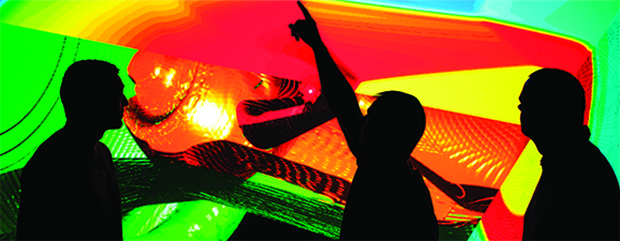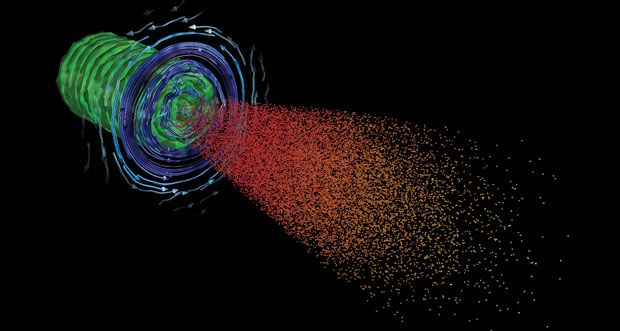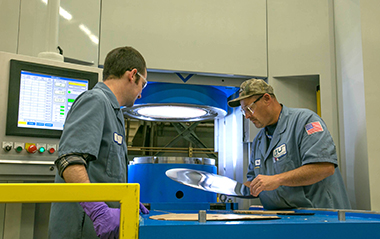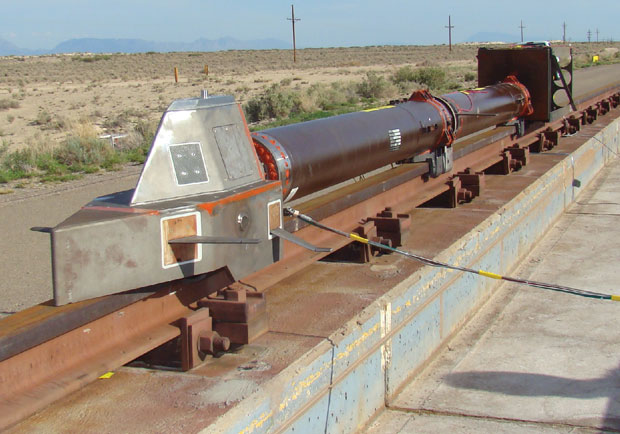LLNL’s foremost responsibility is to ensure the safety, security, reliability, and effectiveness of the nation’s nuclear arsenal. The knowledge gained through experiments, theory, and simulations is applied to assess the condition of stockpile weapons and to develop and certify needed modifications with confidence in the absence of nuclear tests.
Annual Stockpile Assessment
In FY2013, LLNL increased rigor and quality in Cycle 18 of the annual stockpile assessment. As part of the overall process, the nuclear design laboratories (Livermore and Los Alamos) each conducted a comprehensive peer review of the other’s designed weapons. Laboratory scientists continue to improve the baseline weapons-physics simulation codes that support the annual assessments and certification of weapons. Ongoing experimental programs provided data that enabled marked improvements in the predictive capability of weapons physics models for simulating high-explosives performance and the dynamic properties of materials.
Life-Extension Programs
NNSA and the Department of Defense are engaged in an option selection, detailed design, and costing study (Phase 6.2/6.2A) to extend the life of the W78 warhead on Minuteman III, which has aged beyond its planned service life. Options are being considered for interoperability of the nuclear explosive package with the U.S. Navy’s W88 delivery system. In addition to addressing aging concerns, the W78/88-1 life-extension program (LEP) is examining incorporation of enhanced safety and security features as part of the changes that would be made to the warhead. Technical information developed at LLNL, which is the lead nuclear design laboratory for the effort, is enabling an early focus on the preferred design concept and down-select of the pit and nuclear explosive package.
LLNL is partnered with Sandia National Laboratories–California to develop concepts for the U.S. Air Force’s bomber-delivered Long-Range Stand-Off (LRSO) weapon to support the NNSA goal of an early warhead down-select. The California team is considering options ranging from minimal changes to existing warheads to full LEPs, identifying best choices for the LRSO weapon, and recommending the prompt start of a Phase 6.2 study.
In support of LEPs, LLNL is exploring the potential use of additive manufacturing techniques for cost-efficient production of weapons parts. In addition, the Laboratory worked with Los Alamos to produce the first engineering-development-unit W87 pit, demonstrating the production of another pit design in the PF-4 plutonium facility at Los Alamos.
Advances in Supercomputing
In April 2013, the Sequoia supercomputer transitioned to classified operations as a user facility in support of the Stockpile Stewardship Program. The IBM BlueGene/Q machine, capable of performing at 20 petaflops (quadrillion floating-point operations per second), demonstrated its remarkable capabilities in record-breaking simulations performed before the transition. For example, an international team of scientists won the Gordon Bell Prize in 2013 for a 13-trillion-cell fluid dynamics simulation of a collapsing cloud of bubbles.
Sequoia greatly enhances the ability to assess the condition of the stockpile, understand aging issues and resolve significant findings in weapons systems, and carry out LEPs. Sequoia enables higher-fidelity physics models in simulations and makes it possible to run large suites of simulations to better quantify uncertainties.
As Sequoia moved into classified operations, NNSA reached a key step (Critical Decision-0) toward acquisition of the next major computer platform to be deployed at LLNL. The machine, called Sierra, is planned to go into service as a tri-NNSA-laboratory resource in FY2018. LLNL is working with Argonne and Oak Ridge national laboratories on the five-year effort. A request for proposals will be released from LLNL in FY2014 for the acquisition of three systems, one for each laboratory. It is expected that the LLNL system will operate at between 100 and 200 petaflops (peak speed).
Stockpile Stewardship Experiments
A wide range of experimental activities in FY2013 advanced nuclear-weapons scientific understanding and supported the needs to sustain the stockpile and pursue LEPs. Exceeding last year’s pace of experiments, researchers fired seven “hot” shots and six surrogate shots at LLNL’s Joint Actinide Shock Physics Experimental Research (JASPER) facility, located at the National Nuclear Security Site in Nevada, to investigate the properties of plutonium shocked to extreme conditions. In addition, 86 high-energy-density science experiments were fired at the National Ignition Facility, a threefold increase over FY2012 (see National Ignition Facility for details).
Laboratory scientists fast-tracked work on two integrated weapons experiments (IWEs) at hydrodynamic testing facilities at Los Alamos and the Contained Firing Facility (CFF) at LLNL’s Site 300. A surety experiment also was conducted at CFF related to the W78/88-1 LEP. In one case, typical preparation time of 18 to 24 months was shortened by a factor of two. Altogether, five IWEs were prepared for execution in early FY2014. Other experimental activities included tests at Site 300 to understand the thermal loads on the B83 bomb and ensure that the weapon system meets performance requirements.
Foster Celebration
Celebration of John S. Foster, Jr.’s, 90th birthday included a roundtable discussion of nuclear weapons program evolution since Foster’s breakthrough weapon primary design in the 1950s. The panel included essentially all former leaders of LLNL’s primary-design division (B Division). Foster (far left) was joined by two former LLNL directors, Michael May (second from left) and Michael Anastasio (fourth from right), and Los Alamos Director Charles McMillan (second from right). Current B Division leader Michael Dunning (right) moderated the panel.









